Wisconsin Democrats Pull Primary Candidates Against Fake Democrats
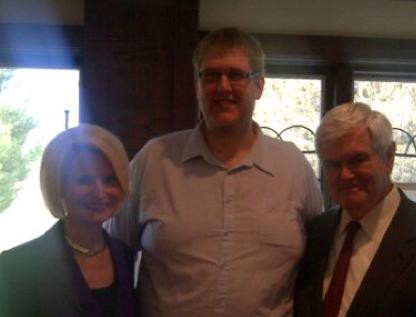
Welcome to the craziest moment in American politics. So, Republicans were going to force Democratic primaries in Wisconsin, alongside the six Republican state senator recall elections, by running fake Democrat candidates. So the Democrats had selected “placeholder” candidates for those primaries. Today, they announced that, since all the Republican-backed but Democrat-registered candidates have now filed to run, the Democrats won’t deign to run candidates against them in the primaries, because it’s a crazy waste of time and taxpayer money. Boom! Crazy right? Would you like to know more? Here is our helpful explanation of the whole Wisconsin mess. Related: this is a picture of suddenly-Democrat James Smith, who has just resigned his commission at the local Republican party to run as a Democrat for office in Wisconsin, so that he can run against his good pal Dan Kapanke in the upcoming recall election. It’s really just disgusting!
When to Wear Pleated Pants (Mostly Never)
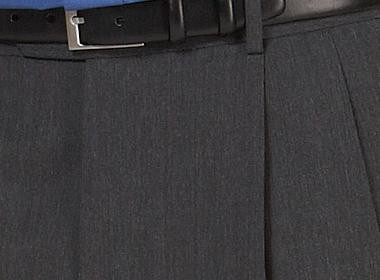
There are many wonderful types of pleats in human clothing. Men benefit from almost none of them. Women, they get several specific varieties of pleat, nearly all of them terrific. Cute little knife-pleat skirts that go whoosh! Dramatic dresses that bulge and shrink! Men get, what — an attractive way for shirt arms to narrow as they approach the cuff. Or a nice way to gather and “box” fabric just above the middle of your shoulder blades. Also, zzzzz.
Worse, pleats also come to harm us. The most odious affliction of mens’ clothing is the reverse pleat at the front of many of your man-pants. Oh wow, you might not know what you look like, let me show you!
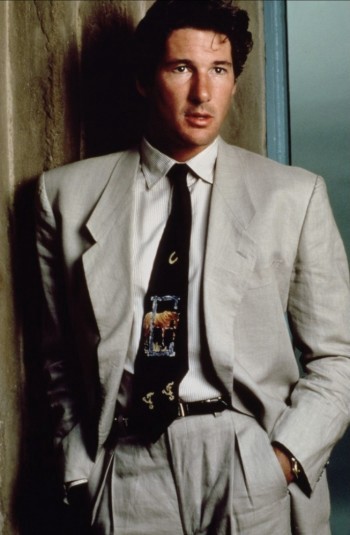
And that’s if you’re LUCKY. Like yes, you should be so lucky to look like Richard Gere on the cusp of the 80s.
But mostly you’ll look like Seth Rogen circa 2006. Or like the bad guys in Beverly Hills Cop. Or worse, Judge Reinhold. I mean, even Gordon Gekko lost the pleats between movies.
Pleats say: I am an affable man! I like being casual! I am gently prone to both intellectual softness and the comings and goings of physical flab! They mostly say “I have given up.”
And every once in a while, if I may be frank, they do good things to your… front areas.
But really? We can all make a pact together to never ever wear pants with pleats, unless they are incredibly expensive and over-stylized and intentional.
You may have noticed that I singled out “reverse” pleats for particular scorn. Reverse pleats are what you’re used to, most likely: they “face” the pockets. The fabric of forward pleats opens toward the fly. Forward pleats run the danger of making you look a bit hip-heavy! (Which is exactly what happens to Sean Connery here, although they’re also kinda cool-looking suit trousers.) And they are old-fashioned, and maybe that’s what you want to be.

Also if you would like to know how sophisticated and fascinating the making of pleats is, here is some very cool information about pleating, including PLEAT MOLDS! This is actually helpful if you like to talk to ladies and have ladies like you, because, as you may have noticed, people in general like compliments. So if you can say “Wow, that is a groovy dress, love the pleats,” ladies may be like “hello, man who notices things.” (Don’t do this: “That nice dress has fabulous plissé pleats,” unless you are in a bad romcom where you are pretending to be gay to get the girl, which REALLY DOESN’T WORK, so just don’t ever get yourself cast in that romp.)
And finally? Sad news! This is the penultimate installment of our absolutely life-changing column on how men should dress in and around the office. Why don’t we end with some questions for next time? Send me a private email communication and I’ll answer your questions next time, IF YOU DARE. (I mean, I’ve already been doing lots of individual counseling on this topic, for which many of you throwing summer weddings should be very grateful, as I’ve vastly improved the visual quality of your guests.)
Sponsored posts are purely editorial content that we are pleased to have presented by a participating sponsor, advertisers do not produce the content. This series/post is brought to you by Gillette. Learn more about Gillette and its products at Gillette.com.
A Q. & A. With Skyzoo, Mixtape Master
by Chris O’Shea
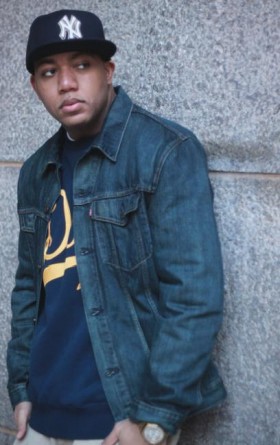
When I was in eighth grade, I was madly in love. But the girl, who I wanted to marry and sometimes wrote sad poems about, didn’t feel the same way. So I decided to prove my love with a mixtape. For me, music was (and still is) the most intense force in the world, so I thought this would truly make her reciprocate my affection. I set my plan in motion by stealing my oldest brother’s Motley Crue cassette, putting pieces of tape over those tiny holes so I could record over the screeching of Vince Neil, and adding songs to my mixtape that would show just how great I was. I gave the tape to the girl the next day. A few days later, she told me that it was “cool,” but somehow it didn’t sway her romantic opinion of me. It might have had something to do with one too many Metallica songs, which were moving to me, but somehow not to her. But at the time, having her tell me that the mixtape was cool was a victory in and of itself.
The mixtape is a powerful thing. As a kid, they were a way to show how much you cared about someone. For others, like those in hip-hop, the mixtape is a way to get their music to the people who crave it. It’s not an album; it’s much more personal. Though the mixtape hasn’t been a “tape” for many years now, the idea — that this highly personal collection of songs can move minds — remains the same.
Skyzoo, a 28-year-old emcee hailing from Bed-Stuy, is a mixtape genius. You might remember him from battling Jin on 106th & Park’s Freestyle Friday (and if you do, you know he was robbed), but since then he has carved a career out of putting excellent mixtapes out, in addition to one major label album.
His latest, The Great Debater, released just last week. Much like his previous efforts, it’s a brilliant collection of tracks that show hip-hop in its purest form. Because he’s a master of the medium, and because he came up as physical tapes disappeared and hip-hop blogs emerged, I asked him some questions about mixtapes and how they shaped him as an emcee.
Artists like Grandmaster Flash and Kool Herc began experimenting with mixtapes in the 1970s. A lot has changed since then, but what do you see as the biggest change in how mixtapes are presented?
The biggest change is obviously the way mixtapes are received. They went from cassettes and CDs that you paid $5-$10 for, to logging on to your computer or iPhone or iPad and downloading them for free via a plethora of blogs, music sites and social networks. A big piece of the expenses to make a mixtape has been taken out, and the option of getting your mixtape literally around the world is now a reality.
How did you perceive mixtapes when you were growing up? Were they a hot commodity in Bed-Stuy? If so, which tapes were getting the most play?
Mixtapes were a way of life when I was growing up. It was all about who had the newest tape, and that one tape ran the city for about a month, month and a half, until the next tape came out. When I was a kid, there were a bunch of big DJs putting out tapes, but the one DJ, hands down, was DJ Clue. When a Clue tape came out, everything stopped. The race was to be the first one in your neighborhood or school with the newest Clue tape, thus giving you access to the newest LOX freestyles, or Jay-Z remix or Nas record, before anyone else who hadn’t gotten to the mixtape spot yet to buy their own copy.
Emcees often say that mixtapes are a way of keeping the hype going in between albums. Do you ever worry that your mixtapes will be better than your albums? Does it matter if they are?
I personally don’t worry about that, because I know how to make a mixtape and an album, where they both do what they’re supposed to do. To me, a mixtape is more free spirited, more “shock and awe” inducing, as far as witty lyrics and punchlines. In today’s day and age, mixtapes are now spawning radio singles and videos, so you’re more aware of that reality and you keep that in mind when recording. But the general idea of a mixtape is to just keep it open and have fun. An album is where your themes, story lines, concepts, song writing, singles, etc. all go. The only artists who make mixtapes better than their albums are the ones who haven’t grasped the idea of what a complete album should sound and feel like. Song writing is key.
Mixtapes typically feature beats that have been used before, but The Great Debater doesn’t; it’s all original production. Why did you decide to go that route?
Well, throughout history, mixtapes have been built around other artists’ instrumentals, but I’d say since about 2009, 90% of the mixtapes that are released are all original music. The only thing that separates mixtapes from albums nowadays is that mixtapes are free and albums are $9.99 and up. Music has gotten so fickle now, and there’s so much of it being released so rapidly, you have to offer your fans more. They aren’t satisfied with you rapping over other people’s beats that they already have in their iPods. They want your mixtape to be great and your album to be greater, with the material all being 100% new.
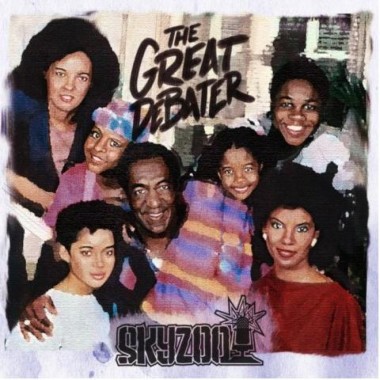
You’ve penned a few critically acclaimed mixtapes and an album, where do you place The Great Debater in your discography?
The Great Debater is definitely amongst the top of my ranks as far as what I feel are my best pieces of work. I don’t like to compare my mixtapes to my albums because they have different goals, so to me its not fair. But if you look at all of my mixtapes, it’s easily the best one, hands down.
It features a picture of the Cosbys on the cover. Why?
The theme of the project is loosely based around the Huxtable family. The idea is that, to me, growing up, I always thought the Huxtable family represented winning. To have a beautiful wife, huge home that you owned, dope kids, doctor and lawyer money, Park Slope Brooklyn, to me, that was winning. I strived for that as a kid and pictured me in those sweaters and in that household. So essentially, the tape is all about winning. Success, and all that it takes to get there via this twisted music game.
Do you approach an album differently than a mixtape?
Definitely. I save all of my more deep, story telling and concept driven emotions for my albums. I’d never put “For What It’s Worth” or “Like A Marathon” or “Under Pressure” on a mixtape, which is why they went on The Salvation [his major label debut]. And I’d never put “Rap Like Me” or any of those types of records on an album, which is why that type of material is on The Great Debater. They’re all incredible records, but each has its purpose.
Hip-hop blogs like Nah Right and others have definitely impacted mixtapes and the way “underground” emcees like yourself are heard. Would you say their proliferation has helped or hurt the game?
I’d say it’s definitely helped. To be able to get your music all over the country, and then all over the world, via a website, is incredible. When I started out, the blogs were in their beginning stages, so it was still about going to the mixtape spots, sneaker stores, mom and pop record stores, etc, and getting your tape in there. I traveled all around NY, Philly, Boston, Connecticut, Virginia, D.C., Baltimore and beyond, physically putting my tapes in stores. Now I just send out an email and it’s all over the blogs in five minutes.
If you had to pick one track from The Great Debater to play for someone who typically doesn’t listen to hip-hop, which would it be and why?
If I had to choose one, which would be tough, it’d be “The Definitive Prayer.” On that song, I just rapped and rapped and rapped some more. There’s no hook, no added effects or sounds to mesh with other genres; just straight beats and raps. When I wrote that record, I just did everything I felt when I heard the beat. The horns, the drum rolls, the keys, it all screamed “hunger,” so I expressed that lyrically. Hip-hop started out as a way to express angst and hunger, and I’m not into staying in the past at all, but if someone has never heard hip-hop before, I’d suggest that they start there.
Chris O’Shea is a writer living in Brooklyn. He once saw Nelson in concert.
Photo of Skyzoo by Mookie X. Photo of The Great Debater by Skyzoo.
Success Robs Small Town Of Its Identity
Success Robs Small Town Of Its Identity
An existential crisis in Boston: Now that the Bruins have won the Stanley Cup, what do the region’s whiny sports fans have to complain about anymore? I mean, apart from actually having to live in that fetid hellhole.
Comic Hero Fanboys Make Terrible Comic Hero Movies
by Matt Ealer
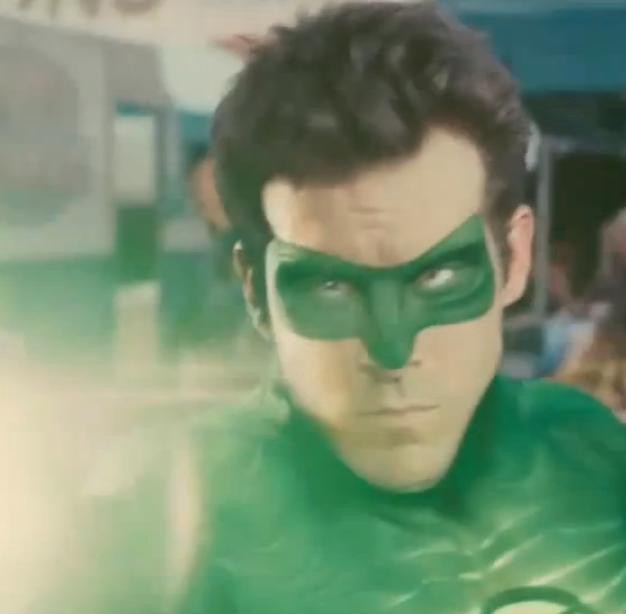
Once a refuge for the maladjusted and the childish — and a cool dip in the pop art pool for the rest of our tired masses trudging through another summer — the comic book movie has shed its pulp trappings. It now strives for middlebrow respectability as a box office tactic. The new pitch is: After a hard day of tooling around in your Prius listening to “This American Life,” why not come to the theater and spend some time with your pal Iron Man (played by Less Than Zero star Robert Downey Jr., so don’t forget to get a head start on your 80s party!) instead of curling up in front of the DVR full of “Men of a Certain Age” and “True Blood” with a Trader Joe’s meal-ready-to-eat?
The problem? The inmates have taken over the asylum. The combination of Christopher Nolan’s runaway success — critically and commercially — with The Dark Knight and the filling of the ranks of the comic book creators, and in turn the properties they parent, with fanboys who take the material Bible-seriously has landed us in an ugly situation. Riding in on a verdant glow polished so bland it’s nearly unrecognizable, Green Lantern isn’t saving anyone’s day. Fill a cast and crew with true cool indie-dad believers in comic book as the best art form, and you get a smooth and endless mélange of pap.
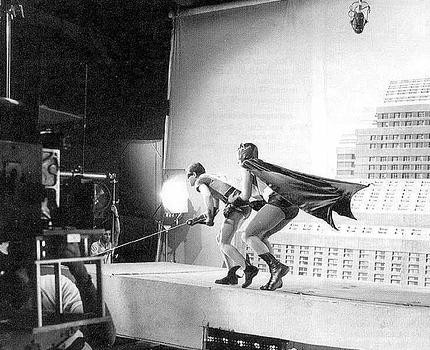
Once, the people at the helm were more likely TV execs laughing at a screening of the hokey “Batman” serials of the 40s with the hip kids at Chicago’s Playboy Club. These were people who readily attested to loathing comic books, and we got the Adam West “Batman”: an enduring icon with a theme song that remains in everyone’s head without the benefit of a proper DVD release. This was rock candy pop art that gives mid-60s Godard a run for its money without even trying.
And the people who actually made comic book movies were a bunch of megalomaniacs arguing to this day over copyrights, who would switch out directors in the middle of filming because the first one just isn’t playing ball, who weren’t afraid to cast unknowns, and we believed a man can fly, in Chris Reeve’s Superman.
Tim Burton, Jack Nicholson and Michael Keaton were all ambivalent-to-hostile to the idea of comics. Nicholson famously angled for the biggest single movie paycheck to date and demanded top billing even though the movie was named for Keaton’s character. Keaton tells the story of taking a moment with Jack to remind each other that they were grown men in these ridiculous getups on set. And while the nerds still bitch and moan about Batman smilingly strapping a ticking bomb to a goon, on any street corner the t-shirt design you see is the one from 89’s Batmania, a yellow oval stark against black — not Nolan’s later art school cool that wouldn’t look out of place on a set of high-end speakers.
Those now grasping at mainstream legitimacy are not their studio exec-bosses with a strict money aim or auteurs slumming, they’re fanboys, desperate that the rest of the world should look at these things with the same reverence they do. With Green Lantern, DC Comics writer and svengali Geoff Johns is listed as co-producer, and it shows.
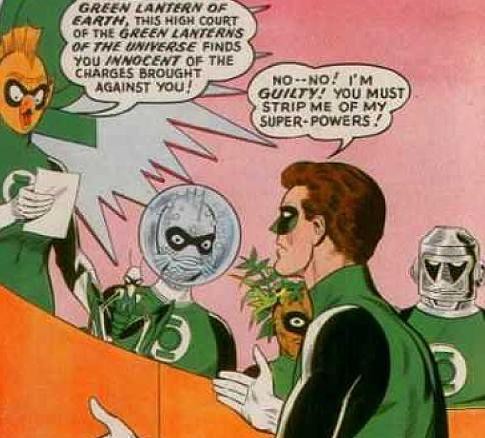
Like Johns’ comics plots — long story arcs that seek to build an Official History arguing for, say, Green Lantern’s very important status not just in DC lore but in the broader culture — the movie tries to cram way more into an origin story than is necessary. There’s the entire history of the Green Lantern Corps and its Guardian overlords. There’s a tedious yet superficial sketch of the backgrounds of Hal Jordan and Carol Ferris. These two should be the main characters of the movie, yet they somehow never seem to be amid all the sound and fury.
There’s 10 minutes of backstory exposition before the movie even starts in earnest like a Star Wars “Last Time on Star Wars” roll, illustrated with $100,000 of CGI that leaves the geeks slobbering and the normies running for the concession stand. (Perhaps it was a vertical marketing strategy?)
And as with Johns’ own plots, this is all shoehorned in with comforting allusions to previous superhero lore, at once a familiar palliative to the general audience and a winking aside to the true fans. Here is the helicopter rescue from Superman: The Movie; here is the nebulous world-eater from the second Fantastic Four movie; here is the city battle from Superman II; here is Jim Carrey’s turn as Edward Nigma regurgitated by Peter Sarsgaard.
Ryan Reynolds plays Jordan as a bratty, pouty bad boy who “doesn’t play by the rules.” The Hal Jordan of the comics was an intergalactic super cop, the one DC hero that was more of a boy scout than Superman, who needed an entire new title in the early 70s filled with Green Arrow scowling at him: “Lighten up and open your eyes, pig.” No, audiences won’t relate to that, you see. And the fanboys running the show would much rather have a chiseled, lady-chasing and potty-mouthed Reynolds as their Mary Sue avatar. (This is a byproduct of the Apatow creep: nerds and doofuses can actually have sex now, so they want someone more sex-getting to identify with.)
And still the movie plays it so safe that you’re left checking your watch. At no point is the audience filled with anything approaching awe, and you’d be hard-pressed to make the argument that they’ll walk away more conversant on the Guardians of planet Oa or with a burning desire to see Sinestro turn, erm, sinister.
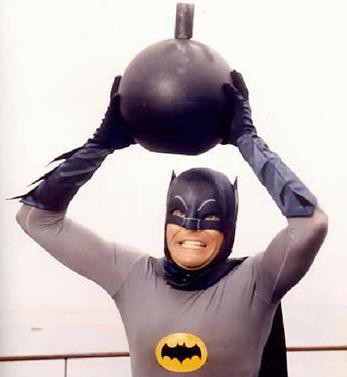
Despite the joys of Nolan’s Batman world, it’s sad that a Teutonic, dour, humorless prig of a Batman would be the new model for comics on the screen. Give me West lecturing Burt Ward about proper dental hygiene before they head out to take on a squawking Burgess Meredith and his array of deadly trick umbrellas, any day.
When we’re left with not-entirely unpleasant but completely forgettable rolls of filler like Green Lantern, it’s enough to make you think Ang Lee’s Hulk was the last great superhero movie. Because it wasn’t afraid to fail, even as it failed spectacularly.
Matt Ealer could go on but unlike some people making movies he doesn’t want to bore you.
England, Your England
“Pallid youths loiter on benches, some of them straining to hold the leashes of ugly, compact dogs. Chain-smoking women and teenage girls with prams cackle by the gaudy yellow frontage of one of the many Cash Converter shops.”
— This is a description of the British town of Accrington, but, really, it could be anywhere on Knifecrime Island.
Peach Honey Chamomile Ice Pops (With Bourbon!)
Peach Honey Chamomile Ice Pops (With Bourbon!)
by Emily Morris

When was the last time you had an ice pop? Was it one of those tongue-scraping plastic tube things that they give you at Field Day? Please don’t tell me you prefer Sno Cones. Those are awful, and nobody admits it because they’re afraid of messing with nostalgia.
Anyway, why eat crushed ice with cough syrup on top when you can make yourself a perfectly lovely frozen treat at home with not much effort? Specifically, these lush, peachy, honeyed ice pops, from a recipe kindly provided by Nathalie Jordi of People’s Pops. And one standout benefit of making ice pops at home: You can spike ’em with booze if you want. (These particular pops go best with bourbon and are thus a great excuse to carry your Bourbon Day celebrations through the weekend.)
Peach Honey Chamomile Ice Pop (with Bourbon!)
4 tree-ripened yellow peaches (20 oz)
2 slightly soft white peaches
1 bouquet fresh chamomile flowers (see substitution below)
2 fl oz (¼ cup) fresh honey
1 fl oz (2 tbsp) freshly squeezed lemon juice (½ small lemon)
a pinch of kosher salt
Optional: shot of liquor of your choice (Nathalie recommends bourbon)
Rinse, halve and pit two-thirds of the peaches, and puree (skin and all) until the mixture is almost smooth. Transfer to a container with a pouring spout and stir the honey, lemon juice, salt and three finely minced chamomile flowers in with the pureed peaches. Coarsely chop the remaining one-third of peaches and combine with puree. Add honey until you can taste it. (Note: Make pops a tad sweeter than you think. They lose a little sweetness after freezing.)
Pour the mixture into your ice pop molds (or Dixie cups!), leaving a little bit of clearance at the top for the expansion that occurs when liquids freeze. Insert sticks and freeze until solid, 4–5 hours. This will make ten delicious ice pops.
Let’s do this!
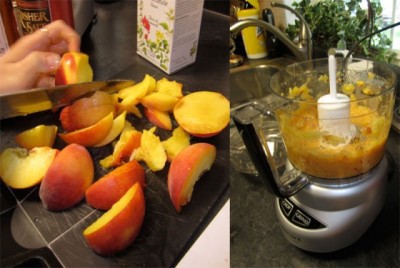
With the skin on, puree 2/3 of your sliced peaches. The remaining 1/3 will be added later. Add in the honey, lemon juice, salt and chamomile flowers.
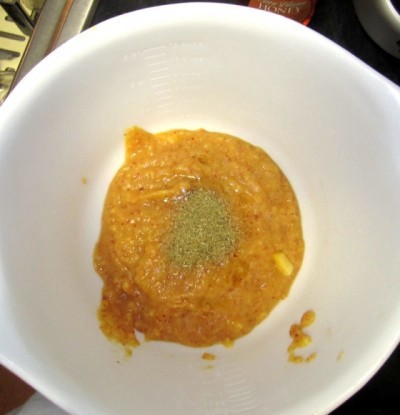
My local farmer’s market did not have fresh chamomile flowers, so I used about ¾ of a chamomile teabag, which worked splendidly. If you’re mincing fresh flowers yourself (go, you!), use the fineness of tea flowers as a reference point. Those who prefer less of an herb flavor may want to use half a teabag.
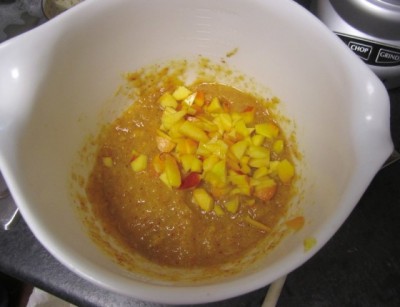
Stir in the remaining peach chunks. Some people are babies about texture and resist the idea of chunks of deliciousness in their food. Don’t be afraid of the chunks! They’re the best part when the pops are all done. Because peaches are in season, they retain a lot of their juiciness even after they’ve been frozen. Chunks. Do it.
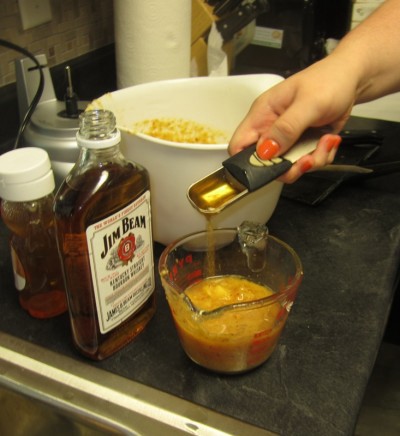
After the mixture was made, I split it in two and poured a shot’s worth of bourbon into one of my containers. According to Nathalie, “as long as less than 20% of the pop comes from alcohol, it should freeze fine.” Next time I might add a bit more honey to the bourbon mix to compensate for the alcohol flavor.

Pour the mixture into molds, leaving a little room at the top for expansion. The recipe makes ten pops, though I only had enough for seven thanks to my novelty rocket molds.* Now just wait until they freeze, obviously.

All done! There you have it. A heavenly pop made from simple ingredients, sure to cool you down on a hot summer day.
* Fun fact about peaches: pureed, their color is vaguely fleshy! Less vaguely so when frozen. My rocket-shaped pops were obscene.
Emily Morris is a summer Awl reporter.
There Are Some Big Old Lobsters
How old can lobsters get? How large can they grow? WE DON’T KNOW! [Via]
Drink Responsibly
This’ll be handy for those of you watching your weight: “The chart below shows alcoholic beverages sorted by their calorie to alcohol ratio. The idea is to get drunk with the fewest calories.” [Via]
Jim Leyland Wants To Know Your Intentions
by David Roth and David Raposa

David Roth: Sorry to be late. But I wanted to watch the end of the Mets game, and K-Rod’s post-save Jesus-Thank has gotten so elaborate and time-consuming. The game ended almost 10 minutes ago.
David Raposa: Yeah, I turned the channel after he brought out the crown of sunflower seeds.
David Roth: Any savior worth worshipping would’ve appreciated it, though. The God I believe in really would appreciate Rodriguez laying out the money to hire the Blue Angels for that flyover.
David Raposa: It’s too bad there aren’t more Scientologists in MLB. I’d love to see the tats and semaphore they’d employ to give L. Ron some love.
David Roth: I’m sure Juliette Lewis is recruiting Casey Blake really aggressively. “You know all those pop-outs and oblique strains?” she’s leering at him over the phone. “Yeah, those are all blowed-up aliens inside your body messing with you.” Which I’m sure he already suspected.
David Raposa: Thetans would be a great way to explain Bruce Bochy’s love of the bunt.
David Roth: Maybe David Miscavige could buy the Dodgers?
David Raposa: Not after McCourt made this week’s payroll!
David Roth: Okay, well after McCourt doesn’t make the next payroll, then. Elaborate hazings for the bullpen at a secret High Desert ranch couldn’t really hurt their performance, right? Put some E-meters in the dugout. Beck takes over as manager.
David Raposa: I’ve heard great things about Giovanni Ribisi’s gyroball.
David Roth: A paunch-faced Jason Lee and a spookily blissed out Anne Archer take over as first and third base coaches. It’s like Major League, but with far flatter affects and more acronyms and the GM has to live on a boat and there are the elaborate secret-ranch hazing rituals. Otherwise it’s exactly like Major League.
David Raposa: I shudder to think what Roger Christiansen would do with the cardboard stand-up of Stripper Xenu. Besides Dutch-angle the hell out of every frame it’s in, that is.
David Roth: On a not very different note, I have not seen a baseball player look sadder or more gaunt or more like the sickly kid from “The Simpsons” than Jason Bay has during his time with the Mets. I feel like he should start coming up to bat to really sad songs.
David Raposa: But how many sad Barenaked Ladies songs are there? (Canada!)
David Roth: I find them all terribly sad.
David Raposa: We should stop with the shameful regional bias. I don’t want Awl Nation to accuse us of Red Sox/Mets favoritism.
David Roth: Merely because those are the only teams we talk about? Oh, they’re bigger than that.
David Raposa: That said: holy shit that Dice-K what a maroon etc. Actual headline: “Dice-K like a bad Toyota.”
David Raposa: “Jason Bay like a rat-infested Tim Horton’s.”
David Roth: “Luis Castillo like a bodega that sells dented cans of Hormel Chili for $2.35.” This isn’t so difficult. “Todd Coffey like a room-temperature beer keg that is somehow sentient enough to be having a terrible day.”
David Raposa: “Dan Uggla like the yeast-ridden cooch of a middle-aged Hooter’s waitress.” If only The National were around now. Frank Deford would be paying us mad money.
David Roth: “John Lackey like a Frankenstein-headed golem that can’t throw in the 90s anymore.” It just comes right out!
David Raposa: You crazy for that one, Lupica!
David Roth: These guys are all proof that every free agent should throw an absurd contract demand like that out there first, just to see. If it’s Bill Bavasi or Sabean or someone on the other end of the phone, you could wind up very rich.
David Raposa: I think the Jayson Werth contract was achieved using your methodology.
David Roth: “We are asking for 33 years and $411 million. Totally straight-faced, by the way.”
David Raposa: Exorbitant number + hollow, ridiculous threat to sign elsewhere = 30 year olds signing for $120 million
David Raposa: “If we don’t get that figure, my client has a 10-picture development deal with Paramount, including a starring role in the B’Wana Beast franchise.”
David Roth: “B’wana Beast has the ability to communicate with animals. He also has the ability to merge two animals together to form a Chimera or (how he puts it) he merges the best of two different things to create an unstoppable force.” Cast Travis Hafner in that shit.
David Roth: Budget instantly spirals out of control. Renny Harlin distances himself from the project, etc.
David Raposa: PROJECT DONKEY would take on a whole new meaning. Neil Gaiman just had a writing boner. Or, if you prefer, inspiration in his pants.
David Roth: I don’t prefer any of that.
David Raposa: So! Did you hear the good news about Jose Bautista? He’s still clean, for the time being!
David Roth: So he actually just became the best hitter in baseball after being a .230–12–31 guy for most of a decade?
David Roth: I remember writing fantasy updates for him when I had this job at MLB.com. It was not easy then.
David Raposa: Back when Pittsburgh was screwing him over with their scurvy-like development programs? Al Martin’s wives wept!
David Roth: Career high-point for me, writing stuff like “Depending on how many at-bats Brandon Moss gets going forward, Bautista could be worth adding in sadder NL-only leagues.”
David Roth: That job was bleak. Staying up until 3am writing about what Ryan Langerhans’s 2-for-4, 1 RBI game meant.
“Epic ketchup-packet collection” = he left to do grip work on Napoleon Dynamite, didn’t he?
David Raposa: When you frame the job like that, the arbitrary hot / cold rankings I see in fantasy babble make so much more sense.
David Raposa: “Despite Pujols’ 15 HRs this month, and his career-long track record of excellence, who can say if he’ll be able to maintain this pace?”
David Roth: The best thing about the gig, mostly, was the MLB.com offices. They’re in Chelsea Market, and are just full of amazing random bobbleheads. (Actual bobbleheads, that’s not some euphemism for the people who worked there)
David Roth: I worked from this cubicle that was all Royals stuff — the Royals team producer worked from home, had this epic ketchup-packet collection, and Brian McRae and Mark Gubicza bobbleheads.
David Raposa: “Epic ketchup-packet collection” = he left to do grip work on Napoleon Dynamite, didn’t he?
David Roth: The best bobblehead in there was for Bill James. It looked like a bobblehead for Mahmoud Ahmadinejad. Which is a really good idea, but which is also unsettling at like 2 a.m. Having a bearded figurine of an autocrat nodding at you on your way to the bathroom.
David Raposa: At least Bobble-Bill approved of your #1.
David Roth: I had to do the tweeting on nights when I worked, and they were basically coded cries for help at the end.
David Roth: “Big night for Clint Barmes, 3-for-4 with 2RBIs. I think I might be dying IRL. #Rockies”
David Raposa: So, this is about that time that the hot-shit prospects actually get brought up because of those goofy arbitration rules.
David Roth: Super Two deadline. The most wonderful time of the year? The Royals being all “fuck it, we’re calling everyone up” is kind of inspiring. I guess you want to get your top prospects into the same locker room as Jeff Francoeur and Melky Cabrera as soon as possible. Frenchy shares tips on lengthening your swing and charming beat writers.
David Raposa: “See, kids, this is what we want you to NOT be.”
David Roth: Cabrera talks a lot about eating right.
David Raposa: Melky would definitely share his recipe for scrapple paella with Moose & Crow (no Boris Badenov).
Scrapple paella is being served someplace in the US right now, I promise… Probably by a very serious chef. Some guy with a fork tattooed on his neck who makes a big deal about not serving vegetarians.
David Roth: Scrapple paella is being served someplace in the US right now, I promise.
David Raposa: It’s the new American Chop Suey.
David Roth: Probably by a very serious chef. Some guy with a fork tattooed on his neck who makes a big deal about not serving vegetarians.
David Roth: You’ve seen the video of him picking something off his bat and eating it during his days with the Braves?
David Raposa: Leaving the emerald green grass and azure blue skies of Yankee Stadium totally fucked that young man up.
David Roth: It could’ve been a shard of barbecue blown over from the stands?
David Raposa: I saw a YouTuber claim Melky likes to chew on pine tar. And to be fair, I’ve been known to spray some Pledge on my morning bagel. I like lemon.
David Roth: You get 6000% of your daily recommended vitamin C with just two spritzes.
David Raposa: And my tongue would be dust-free!
David Raposa: Honestly, I kinda wish someone would call us out for our parochialism. “You don’t talk about Hank Conger at all!”
David Roth: I know we only talk about teams reachable by Amtrak Acela, but what’s funny about that is that I talk about Hank Conger all the time. Like to the point where it has impacted my marriage.
David Roth: My wife’s like “one more thing about how he should be playing ahead of Jeff Mathis and I’m leaving this restaurant.” And then I just sit there for a jittery minute, say something about how it’s ridiculous that Jeff Mathis EVEN GETS AT-BATS AT ALL, and chase her down the block.
David Raposa: Is your wife’s maiden name Scioscia, by any chance?
David Roth: Oh man. Meeting Mike Scioscia when you go home to meet your significant other’s parents. Broccoli rabe hanging out of both sides of his mouth.
David Raposa: Those plate-blocking skills probably come in handy. Like when you try to leave after he breaks out his jock strap collection.
David Roth: “I wore this one between 1982 and 1991.” Tom Niedenfuer keeps calling on the cell, with “California Love” as the ring tone.
David Roth: I think Jim Leyland would be the best-case scenario dad in a MLB manager meet-the-parents situation. Doesn’t say much, maybe reads a Clive Cussler book at dinner. Afterwards he invites you out for a smoke and asks some really old-fashioned questions about “your intentions.”
David Raposa: Just give him a highball and some space, and he’s totally copacetic.
David Roth: Rob Roys and Merits. I imagine his house looking like the set from Ordinary People. Deep shag rugs, lots of dim glass lighting fixtures.
David Raposa: Young Andy Van Slyke sulking on the front stoop, hoping to play catch?
David Roth: Judd Hirsch is there for some reason, raiding the fridge.
David Raposa: Judd Hirsch is there for the experiential gravitas factor.
David Roth: And the nubby cardigans, but yes.
David Roth co-writes the Wall Street Journal’s Daily Fix, contributes to the sports blog Can’t Stop the Bleeding and has his own little website. And he tweets!
David Raposa writes about music for Pitchfork and other places. He used to write about baseball for the blog formerly known as Yard Work. He occasionally blogs for himself, and he also tweets way too much.
Photo by Keith Allison.
